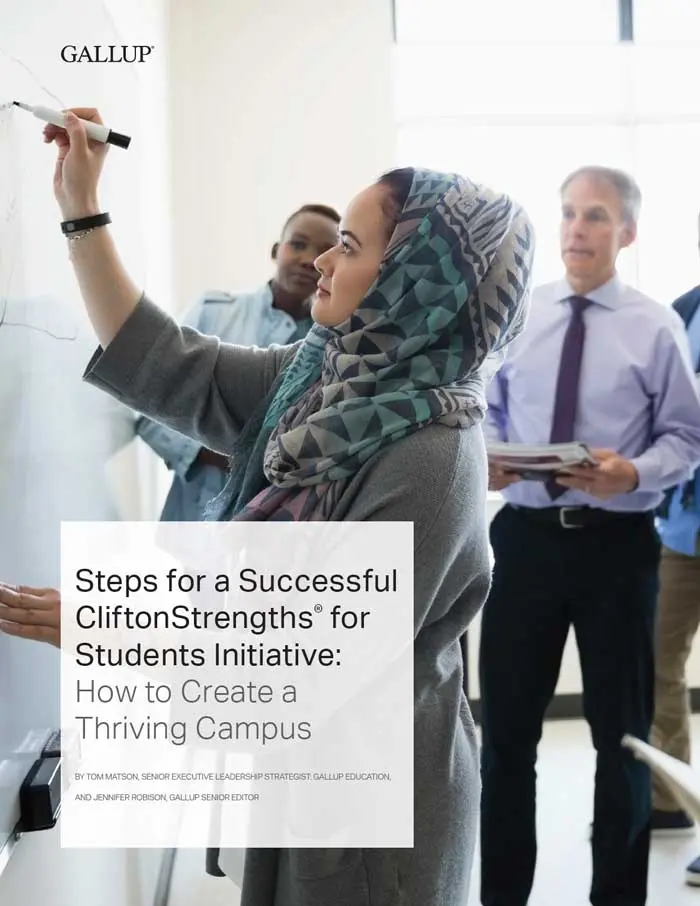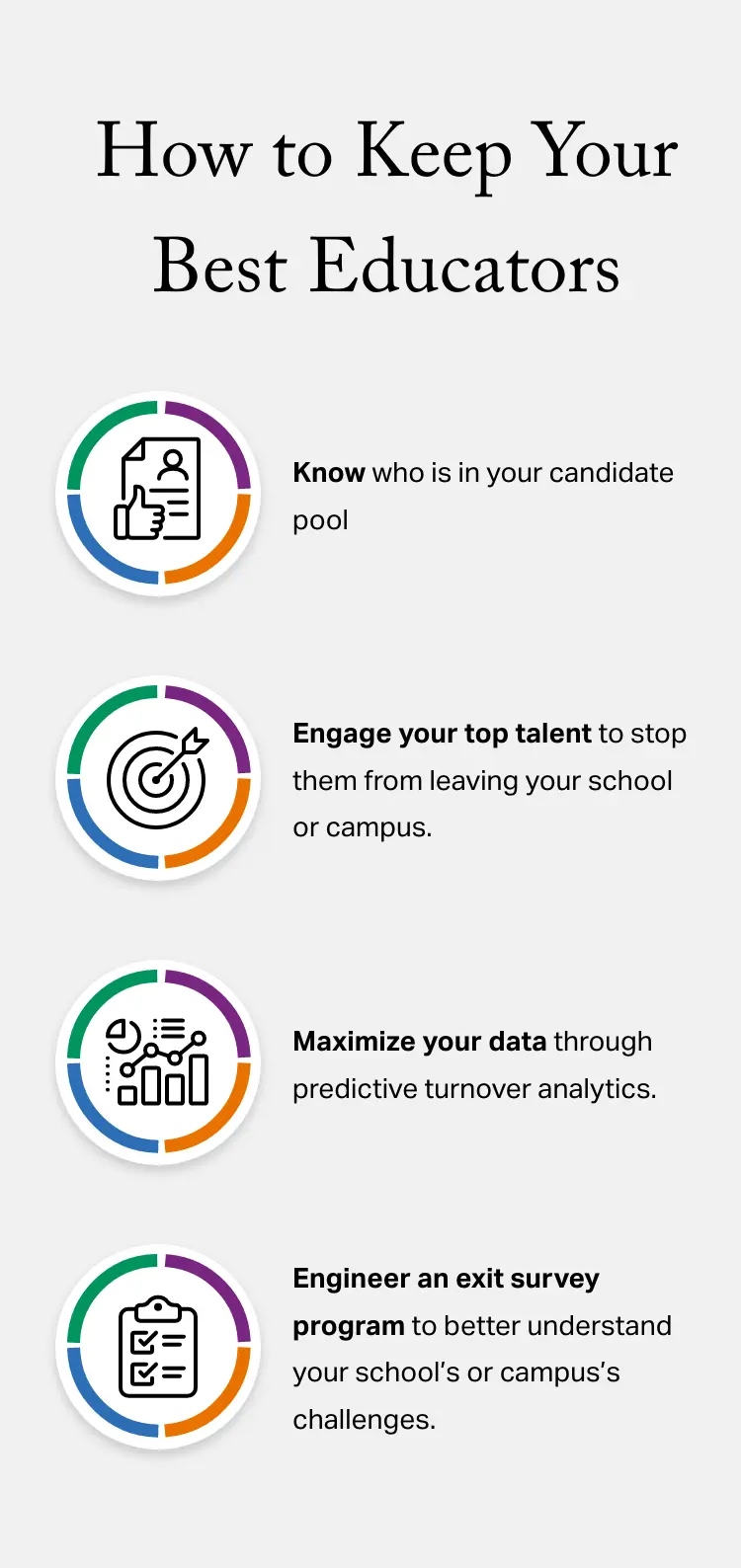How to Improve Teacher Retention and Burnout
According to Gallup’s latest teacher burnout statistics, K-12 education employees and college or university employees report higher burnout rates than full-time workers in any other industry.
While the education landscape is in a seemingly constant state of flux, our goal is still this:
… to be sure there is a teacher in every classroom who cares that every student, every day, learns and grows and feels like a real human being.
-- Don Clifton, Father of Strengths Psychology and Inventor of CliftonStrengths®
To achieve this goal, education leaders, school systems and districts need to place a renewed focus on educator engagement and wellbeing.
Meeting the needs of students, faculty and teachers in the current state of education can feel impossible -- but it doesn't have to be. We can create thriving schools and campuses by implementing proven engagement, wellbeing and strengths-based practices, leading to healthier places to learn, work and live.
Start implementing an all-encompassing approach to educator engagement and wellbeing.
Learn More about elevating your campus experienceHow to Build Teacher Engagement
You're in the business of setting students up for success today, tomorrow and well into the future. However, your campus or school system is also a business. There are faculty and teachers to hire, salaries to pay and the same worries that other businesses face: performance metrics, engagement rates, recruitment, and faculty and teacher retention, to name a few.
This is why establishing a culture of wellbeing and engagement is crucial for success in your school or on your campus. The most critical element of all? Leaders. Higher education leaders or superintendents and principals.
You are critical in the engagement of your faculty and teachers. And when school leaders support teachers, everyone thrives.
Learn More about elevating your campus experienceAccording to Gallup's research, there's a 15% greater likelihood that direct reports will be thriving in wellbeing when their manager is thriving in their own wellbeing. This is why we believe that great principals are the real difference-makers in the school setting. Like other leaders, they are essential to building engaged, thriving schools.
Those with thriving career wellbeing have a deep purpose in life and a plan to attain their goals. In most cases, they have a leader or manager who makes them enthusiastic about the future and friends who share their passion, reaffirming the importance of quality leaders.
When leaders invest in employees' engagement, they are likely to influence institutional growth in the process.
When we asked employees the question about whether their manager cares about them as a person, we found that people who agree with this statement:
So, how do you create thriving, engaged teachers? It really does start with education leaders, and leaders should start with strengths.
CliftonStrengths is not the why; it is the how. The why is thriving wellbeing and engagement, represented by everything else on this page: higher performance, better work, higher engagement, improved retention, etc.
Implementing a strengths-based approach will help to realistically achieve those outcomes and create a thriving, engaged campus or school. That's your how.

For actionable steps and a framework to help your school's leaders, faculty, administrators and students use a strengths-based approach, download this free guide.
Download GuideEngagement and wellbeing are highly reciprocal, each influencing the future state of the other. And when studied in combination, high wellbeing enhances engagement, hoisting employee performance to levels not found through engagement alone.
High levels of engagement among educators could mean:
Leaders, do you believe your employees would be able to confidently agree with the following items? And if you're an educator, do you confidently agree with the following items?
I have the materials and equipment I need to do my work right.
In the last seven days, I have received recognition or praise for doing good work.
At work, my opinions seem to count.
These are just three of 12 vital statements that help identify an employee's engagement level. And within the education industry, these three serve as a great place to start. Make sure each educator (K-12 or higher education) has the proper materials to do their job, receives recognition for the work they do, and can voice their ideas and opinions in a setting where they are considered valuable.
Increased engagement, combined with higher wellbeing, leads to a happier, healthier educator.
Teacher Retention Strategies That Are Built to Last
The most progressive leaders not only understand that they are in the business of boosting their employees' wellbeing, but also use this knowledge as a competitive advantage to recruit and retain employees.

Recruit Top Talent and High Performers

Leaders know that if they can show a prospective employee how working for their school or campus will translate into better relationships, more financial security, improved physical health, and more involvement in the community, it will be easier to attract top talent.
Teacher turnover and teacher shortages are high; therefore, retaining teachers begins with hiring the right ones.
To hire high-quality talent, there must be a small shift in mindset. It can no longer just be knowledge and skills that you're hiring for.
Knowledge and skills are important, but the problem is in thinking that they're enough. The real ticket to successful recruitment is:
Knowledge + Skills + Talents = Strengths
Is selecting and developing teachers and principals based on their knowledge and skills the most reliable way to promote student success? Success is far more likely to hinge on the innate talents of the teacher, such as their ability to build strong relationships with students.
Certainly, the knowledge and skills are necessary, but they should be treated as prerequisites rather than the primary basis for declaring teachers 'highly qualified.'
Such a classification should be reserved for teachers who display the talents necessary to promote student engagement.
This goes for both campuses and school systems. However, here are three ways (specific to school system leaders) to set principals and teachers up for success.
- Hire talented principals and teachers. Ensure that they possess the right talents for their role.
- Offer transformative learning experiences. Empower your principals with the right professional development and training.
- Support principals with proven systems and processes. Leaders of school systems must forget obsolete policies and implement proven methods like analytics-based attraction and performance development systems that drive high performance.
Take a closer look at your teacher experience by asking the right questions to better understand your education workplace from teachers' perspective. Learn to use those insights to create a culture where teachers are engaged and thriving.
How to Avoid and Prevent Teacher Burnout
The World Health Organization defines burnout as a "syndrome conceptualized as resulting from chronic workplace stress that has not been successfully managed."
We should care deeply about teacher stress and faculty stress for many reasons, but specifically because:
- Teachers and college faculty members are real people with large responsibilities, so their stressors must be taken seriously.
- These high levels of educator stress rates create an unstable environment for students, compromising their academic experience.
Burnout can have very negative consequences on wellbeing.
Employees who say they very often or always experience burnout at work are:
Educators experiencing burnout may exhibit feelings of energy depletion or exhaustion, increased mental distance from their job, feelings of negativism or cynicism related to their job, and reduced professional efficacy.
To put it simply, burnout leads to poor performance and decreased educator wellbeing.
Steps Leaders Can Take to Deal With Teacher Burnout
The causes of burnout are many -- which means that education leaders need to take a varied approach to mitigating it. Burnout doesn't just go away over time. It requires intervention by leadership.
Here are some steps leaders can take to begin addressing teacher burnout.
1. Listen to work-related problems.

Too few managers make frequent employee check-ins and ongoing conversations a high priority. Good leaders know employees as individuals, celebrate achievements, have performance conversations, conduct formal reviews and, above all, respect their employees.
2. Encourage teamwork.

Coworkers provide an essential line of emotional support for educators who are struggling. It's the leader's responsibility to create an environment where teamwork thrives, people help one another, and everyone has someone at work who is willing to listen.
3. Give meaningful recognition.

When leaders give meaningful recognition, they combat perceived inequities and show teachers that leaders see and appreciate their work. It is also an opportunity to showcase how the work that individuals do contributes to the bigger picture.
4. Make everyone's opinion count.

Actively seek the opinions and ideas of your educators. When employees believe their opinions are welcome and make a difference, they feel important and included, and they begin taking more responsibility for their performance. This sense of ownership reduces burnout because it gives employees a feeling of control over their work -- rather than feeling like work is something that happens to them.
5. Create a culture of wellbeing.

When an institution prioritizes workplace wellness and provides resources for employees to live healthier lives, employees take better care of themselves. This means that in addition to ensuring teachers have thriving career wellbeing, education leaders should promote the other four elements of wellbeing: social, physical, financial and community.
6. Reshape teachers' experience at work.

Unmanageable workloads and unreasonable expectations or time pressures are big-time burnout creators. Evaluate teachers' experience at work to locate the pressure points that occur in their work life. It's not possible to alleviate all contributing stressors, but having an awareness of them allows leaders to provide extra support during overly busy or stressful periods.
7. Make work purposeful.

Educators do not want to just work for a paycheck; they want to find meaning in what they do. Leaders must do more than point to the mission statement on the wall -- they must help employees discover how their role and daily tasks contribute to fulfilling that mission.
Burnout doesn't have to be inevitable. When institutions build anti-burnout practices into their approach, it actively promotes development, growth and thriving wellbeing.
Educator Engagement Leads to Student Engagement
What does the "best possible future" for your students look like?
Whatever it may be, student success begins with a focus on teacher engagement. When teachers are meaningfully involved in and enthusiastic about their work, it positively affects their students. Additionally, when students have someone who is invested in their growth and development, it promotes student wellbeing and engagement.
Engagement and wellbeing are highly reciprocal, each influencing the future state of the other. To prepare students for a lifetime of thriving wellbeing, it's important to provide the conditions for engagement in the classroom.
One of the greatest predictors of student success is educator engagement, so it's important to begin there. However, that is not to minimize how vital the individual student experience is in terms of high wellbeing and engagement. That's why it’s important that faculty and staff are engaged and aligned with their institution’s mission and purpose.
The idea of fulfilling every student’s potential … helps reorient our thinking about a simple truth: When it comes to education, the big picture is really determined by the little picture -- what’s best for each individual student.
Higher Education
When it comes to wellbeing in higher education, not enough can be said about the importance of asking students questions and keeping that line of communication open.
Ask your students questions to understand how they are doing in their personal wellbeing:
- Are they thriving, struggling or suffering?
- How are their relationships with friends, family and the broader campus?
- Where are they financially?
- How about in school and future career thinking?
- How are they staying physically healthy?

Higher education gives people the knowledge they need to build an engaged life, and the five elements of wellbeing are the currency of a life that matters.
When you demonstrate to a student that you care, they're more apt to be engaged. And engagement produces positive postgraduation outcomes for students and a lasting emotional connection to their classmates and professors.
Gallup has partnered in research showing that wellbeing, engagement and hope make up one-third of the variance in students' academic success.
Graduates who were emotionally supported during college -- who had a mentor who encouraged their hopes and dreams and professors who cared about them as people and made them excited about learning -- are three times as likely to have thriving wellbeing after college.
They're also six times as likely to be attached to their alma mater. One goal for students during their time spent in school is that they learn how to be engaged employees with a focus on wellbeing.
Investing in the engagement and wellbeing of your students while on campus has been linked to long-term outcomes like higher workplace engagement and wellbeing. How students respond to these six collegiate experiences is linked to student confidence in how successful they will be in the job market:
- My professors at [university] care about me as a person.
- I have at least one professor at [university] who makes me excited about learning.
- I have a mentor at [university] who encourages me to pursue my goals and dreams.
- While attending [university], have you had an internship or job that allows you to apply what you're learning in the classroom?
- While attending [university], I have worked on a project that took a semester or more to complete.
- I am extremely active in extracurricular activities and organizations.
To create engaged students and engaged future alumni, ensure that each student has access to these six experiences.
Although the implementation of strategies to engage students may look different from campus to campus, encouraging students' strengths is a great place to start.
K-12 School Systems

Gallup education data and analytics show that students' engagement and hope for the future are linked to achievement, grades, absenteeism and plans after high school.
Students who are engaged -- involved in and enthusiastic about school -- are more likely than their actively disengaged peers to be hopeful for the future and have better self-reported academic performance. More specifically, engaged students are 2.5 times more likely than their actively disengaged peers to say they get excellent grades and do well in school, and they are 4.5 times more likely to be hopeful about the future.
Measuring student engagement and hope can help identify areas of strength within a school, as well as areas of opportunity where different solutions could be implemented.
In fact, 88% of superintendents agree that student engagement is a key measure of school effectiveness.
Engaged students are:
Although it may seem too "conceptual" to measure, the Gallup Student Poll is a survey made up of the voices of millions of students that has measured students' hope and engagement for over 40 years. The research shows that students' success is linked to their wellbeing, their engagement at school and their hope for the future.
These four elements that the Gallup Student Poll measures are essential for student success:



By leveraging the different items within Gallup's Engagement and Hope Indexes, teachers and schools can decide the best way to implement change to increase wellbeing and engagement within their school system.
Elevate Engagement for Everyone on Campus With Strengths
Lead and Teach With Strengths
When educators learn and lead with their strengths, they help their school community grow. The research-based CliftonStrengths assessment is a powerful tool that gives people a common language and vocabulary to better describe, communicate with and understand each other.

- 1. Self-Assurance
- 2. Competition
- 3. Achiever
- 4. Empathy
- 5. Relator

- 1. Strategic
- 2. Belief
- 3. Input
- 4. Positivity
- 5. Focus

- 1. Learner
- 2. Woo
- 3. Arranger
- 4. Context
- 5. Harmony

- 1. Intellection
- 2. Deliberative
- 3. Communication
- 4. Individualization
- 5. Ideation
Educators can use their strengths to teach and engage in their role in a way that fits their strengths and talents. Their energy and passion can fuel their own great performance and inspire the same from those around them.
Schools and campuses that build a strategy based on strengths see measurable positive outcomes in:
- student, educator and alumni engagement
- retention
- wellbeing
- academic achievement
- sense of inclusion
Employees who have the opportunity to do what they do best (i.e., use their strengths) are 57% less likely to experience burnout frequently and 30% more likely to experience feelings of belonging and inclusion. Why? When people can tap into their strengths, they are more engaged, more effective, less stressed and more focused on doing their best work rather than seeing their job as a burden.
Employees who use their strengths are:

Gallup analytics consistently prove that managers get the best performance from their team members when they identify what their people do best, praise them for it, and guide them into tasks and partnerships that maximize their natural talents.
Engaged, thriving schools begin with educators, so take care of the people who are taking care of your students.
Promote Student Wellbeing, Engagement and Achievement With Strengths

How well do you really know the students on your campus or in your classroom? Better yet, how well do your students know themselves?
Too often, we focus on what's wrong with students: their weaknesses, their "pain points," their problems. We want to develop those actions, patterns, habits, etc., into something more desirable and well-rounded. However, every individual has natural talents and strengths that they can use to succeed in life. Higher education is the perfect place where students can realize and invest in this potential.
CliftonStrengths for Students uses Gallup's research-based CliftonStrengths assessment to measure the 34 talent themes. It connects students' natural talents to their wellbeing and engagement by focusing on what's right with each student.
This is more than just an assessment that your students take, discuss and then forget. It's a way to turn a student's innate talents into performance outcomes.
Set and Achieve Goals

Competition
Part of success for you means you want others to see your wins. Decide who needs to see your successes and wins.
Excel in Your Career

Harmony
You thrive in the presence of others. Think about which jobs or industries will allow you to interact with others, help solve problems and build deep relationships.
Develop Better Study Habits

Woo
Set focused time away from others to work. Use alone time to eliminate distractions, and then reward yourself with social time afterward.
Plan a Schedule and Pick Classes

Strategic
Plan your schedule for maximum efficiency. Strategize your schedule to be efficient and energizing.
Contribute to Group Projects and Extracurricular Activities

Achiever
In a group setting, you bring the impulse to get things done. You inspire others to achieve excellence too.
CliftonStrengths transforms the way students experience their education, sets them up to succeed far beyond the classroom, and develops both individual and classroom engagement.
CliftonStrengths identifies an individual’s unique value to the classroom -- but also centers the individual within the classroom.
Take low student retention rates in higher education, for example.
From a student's perspective, dropping out of college can be a ruinous loss of investment and job potential. From a university administration's view, student attrition is financially hazardous in a time of shrinking budgets. For the institution as a whole, every lost student represents lost alumni funding and a missed opportunity for mission fulfillment.
Handing out CliftonStrengths assessments won't magically reverse dropout rates.
However, by implementing a strengths-based approach to improve student engagement and wellbeing, retention rates will improve as a secondary response to student success and engagement.
Campuses that take a strengths-based approach to student development know that it:





Improve Wellbeing and Engagement on Your Campus or in Your School Today
Don't wait to improve the lives and performance outcomes of your students, teachers and faculty. Learn more about wellbeing, engagement and the power of CliftonStrengths for Students.







